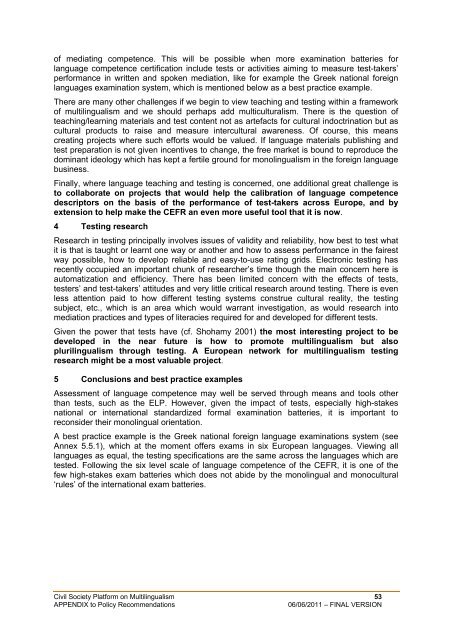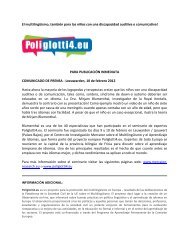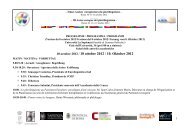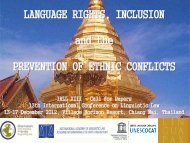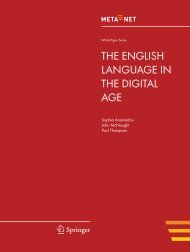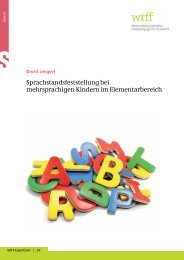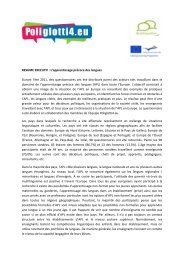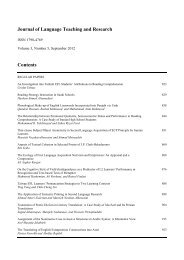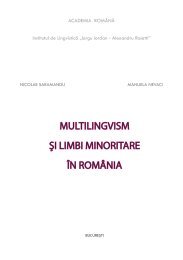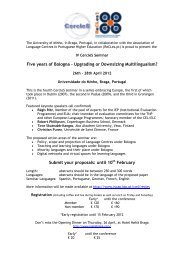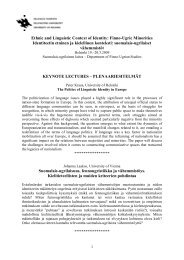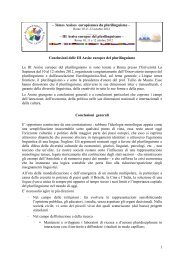tests, self-assessment techniques and feedback systems, increasingly available, especiallyfor the ‘big’ languages.Other, alternative forms of language testing are rare but there is an increasing number ofeducational and work-related institutions which use alternative forms of assessment,including the ELP mentioned earlier.3 Challenges and recommendationsAs has become obvious from the two sections above, the <strong>European</strong> language testingindustry offers services and is serviced by the ‘big’ languages, leaving the ‘smaller’ onesunattended. This has serious repercussions. If people cannot be certified for their languagecompetence, they cannot be credited for their knowledge. This knowledge is in some waysocially delegitimized. Therefore, the first challenge in Europe is to create conditionswhich provide opportunities for people to be tested and credited for the competencesthey do have in different languages. One way of achieving this goal is to facilitate thedevelopment of localized exam batteries which cater to the needs of the local linguistic jobmarkets. Such samples are now available in few countries in Europe – the Finnish and Greekexample already mentioned, there are also interesting ideas by the Dutch testingorganization CITO, and a few others which seem to respond more readily to social languageneeds rather than aim primarily on symbolic and financial profit.The second and most serious challenge is to create incentives for the development ofexamination batteries which test and treat equally a variety of languages, in acomparable manner. Again, localized language exam batteries could perhaps contribute toachieving this goal, as such projects are much more likely to be concerned with the use oflanguage(s) in different social contexts rather than focus on their language commodity as anautonomous meaning system, as international exam batteries have to be.Thirdly, but perhaps the most challenging endeavour of all is to shift from monolingual toplurilingual paradigms in language testing and teaching. That is, a paradigm which hasits basis on a view of the languages and cultures that people experience in their immediateand wider environment not as compartmentalized but as meaning-making, semiotic systems,interrelated to one another. In a paradigm such as this, there is language switching,‘translanguaging’, 37 drawing upon lexical items and phrases from a variety of contexts andlanguages; there is also use of alternative forms of expression in different languages orlanguage varieties, exploitation of inter-comprehension, utilization of paralinguistic features(e.g. facial expressions and gesture), and generally optimum use of various modes ofcommunication to make socially situated meanings. In this paradigm, where people learn tomake maximum use of all their linguistic resources so that they can resort to differentaspects of linguistic knowledge and competences to achieve effective communication in agiven situational context, cultural and linguistic mediators have a most valuable function. Inthe absence of a mediator, such individuals may nevertheless achieve some degree ofcommunication by activating their whole communicative repertoire.Mediation, understood as extracting information from a source text in one language andrelaying aspects of it in another for a specific purpose, is an important cultural activity in ourcontemporary multilingual contexts (Dendrinos 2006). However, mediation skills andstrategies have not found a principal spot in language teaching programmes or internationalexamination batteries, for reasons which are again related to the monolingual practices of<strong>European</strong> language teaching and testing. This is why, although mediation is included in theCEFR (ibid: 87-88, 99), it has not been possible to come up with illustrative scale descriptors37Translanguaging is defined by Baker (2001: 292) as the “concurrent use of two languages, which may involve randomswitching to a more justifiable purposful use of each language, varying the language of input and output in a lesson. Garcia(2009) defnes the term as sense-making bilingual practices from the speaker’s perspective, rather than than from a languageperspective (as code-switching has been viewed). Moreover, she explains that it’s a bilingual speaker’s perspective, and notfrom a monolingual or monoglossic perspective. It includes all student or teacher use of these bilingual/multiple discursivepractices as ‘sense-making’ of learning or teaching in multilingual classrooms.Civil Society Platform on Multilingualism 52APPENDIX to Policy Recommendations06/06/2011 – FINAL <strong>VERSION</strong>
of mediating competence. This will be possible when more examination batteries forlanguage competence certification include tests or activities aiming to measure test-takers’performance in written and spoken mediation, like for example the Greek national foreignlanguages examination system, which is mentioned below as a best practice example.There are many other challenges if we begin to view teaching and testing within a frameworkof multilingualism and we should perhaps add multiculturalism. There is the question ofteaching/learning materials and test content not as artefacts for cultural indoctrination but ascultural products to raise and measure intercultural awareness. Of course, this meanscreating projects where such efforts would be valued. If language materials publishing andtest preparation is not given incentives to change, the free market is bound to reproduce thedominant ideology which has kept a fertile ground for monolingualism in the foreign languagebusiness.Finally, where language teaching and testing is concerned, one additional great challenge isto collaborate on projects that would help the calibration of language competencedescriptors on the basis of the performance of test-takers across Europe, and byextension to help make the CEFR an even more useful tool that it is now.4 Testing researchResearch in testing principally involves issues of validity and reliability, how best to test whatit is that is taught or learnt one way or another and how to assess performance in the fairestway possible, how to develop reliable and easy-to-use rating grids. Electronic testing hasrecently occupied an important chunk of researcher’s time though the main concern here isautomatization and efficiency. There has been limited concern with the effects of tests,testers’ and test-takers’ attitudes and very little critical research around testing. There is evenless attention paid to how different testing systems construe cultural reality, the testingsubject, etc., which is an area which would warrant investigation, as would research intomediation practices and types of literacies required for and developed for different tests.Given the power that tests have (cf. Shohamy 2001) the most interesting project to bedeveloped in the near future is how to promote multilingualism but alsoplurilingualism through testing. A <strong>European</strong> network for multilingualism testingresearch might be a most valuable project.5 Conclusions and best practice examplesAssessment of language competence may well be served through means and tools otherthan tests, such as the ELP. However, given the impact of tests, especially high-stakesnational or international standardized formal examination batteries, it is important toreconsider their monolingual orientation.A best practice example is the Greek national foreign language examinations system (seeAnnex 5.5.1), which at the moment offers exams in six <strong>European</strong> languages. Viewing alllanguages as equal, the testing specifications are the same across the languages which aretested. Following the six level scale of language competence of the CEFR, it is one of thefew high-stakes exam batteries which does not abide by the monolingual and monocultural‘rules’ of the international exam batteries.Civil Society Platform on Multilingualism 53APPENDIX to Policy Recommendations06/06/2011 – FINAL <strong>VERSION</strong>


